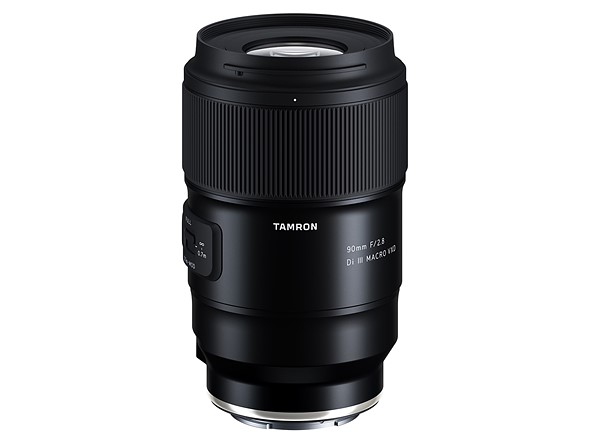
| Image: Tamron |
If you’ve ever taken a look at Tamron lenses, you’ve likely noticed a surprisingly long string of numbers and letters in the product name. Reading “Tamron 18-300mm F/3.5-6.3 Di III-A VC VXD” can feel a bit like trying to decipher a secret code. Plus, when you go to read about the lens, you may discover even more acronyms and terms to figure out. In this article, we’ll break down that code and clarify what each of the abbreviations refers to. That way, you can more easily decide what’s important to you when shopping for a Tamron lens.
Lens type and compatibility
Outside of the focal length and maximum aperture, the first abbreviations on Tamron lenses refer to the lens type and its compatibility. If you don’t see one (or more) of these abbreviations, the lens doesn’t offer that feature or specification.
Di, Di II, Di III and Di III-A
After the focal length and maximum aperture, you’ll find a variation of Di, which is an abbreviation for Digitally Integrated Design. Tamron designed its Di lenses for DSLRs (both APS-C and full-frame), and the Di indicates that the lens is not for a film camera.
These days, you’ll most often see the Di followed by II, III or III-A, which gives a little more clarity on the specific type of digital lens.
- Di II lenses are also built for DSLRs, but only those with sensors smaller than full-frame (up to 16 x 24mm).
- Di III is the company’s mirrorless identifier, referring to lenses made for mirrorless interchangeable-lens cameras (ILCs).
- Di III-A are mirrorless lenses for APS-C cameras.
SP
 |
| The Tamron SP 24-70mm F2.8 Di VC USD G2 is part of the company’s SP, or Super Performance, lineup. Image: Tamron |
On some DSLR lenses, the very first part of the lens name (even before the focal length) is SP. Tamron hasn’t used that designation in its mirrorless lineup, but it stands for Super Performance. It signifies the lens is part of Tamron’s high-end professional lens lineup. As a result, it promises better performance and higher optical quality than lenses without that designation, but it also comes at a higher price than the rest.
Stabilization, focusing system and macro
Next in the lens name is a string of letters referring to the type of autofocus motors and, when present, stabilization or macro capabilities.
VC
 |
| As you can see on these switches, some Tamron lenses offer multiple settings for Vibration Correction (VC). Image: Tamron |
When you see VC in a Tamron lens name, it means the lens offers Tamron’s Vibration Compensation, its version of optical stabilization. VC is mostly found on the company’s telephoto zoom lenses and aims to reduce blur from camera vibrations while using longer shutter speeds.
VXD, RXD, OSD and USD
Tamron lenses use several different autofocus motors, with an acronym for each. You won’t see multiple of these on a single lens, as a lens can only have a single type of autofocus motor.
VXD is one of the more common abbreviations on recent lenses. It stands for Voice-coil eXtreme-torque Drive. The VXD motor is a linear motor focus mechanism, and it is, at the time of writing, the fastest motor in Tamron’s lineup. It allows the lens to quickly, quietly and accurately adjust focus. The VXD is ideal for sports, wildlife or video capture where smooth and quiet autofocus is important.
RXD is another frequent term on Tamron lenses. It stands for Rapid eXtra-silent stepping Drive, a type of stepping motor. Though not as fast as the VXD autofocus motor, the RXD motor is relatively fast and quiet. It is suitable for photography and video applications that depend on quiet operation but not utmost speed.
 |
| The Tamron 11-20mm F2.8 Di III-A RXD is made for mirrorless APS-C cameras (as the Di III-A tells us) and features a Rapid eXtra-silent stepping Drive (RXD) autofocus motor. Image: Tamron |
OSD stands for Optimized Silent Drive, which is also a type of stepping motor. It’s less common on new Tamron lenses, and sits below VXD and RXD lenses in terms of autofocus speed and noise.
Older lenses may also feature HLD or PZD acronyms. HLD stands for High/Low Torque-Modulated Drive; it allows users to use manual focus even when in autofocus mode. PZD, which stands for Piezo Electric Drive, is another type of Tamron autofocus motor typically found in its mid-range and travel zoom lenses.
Macro, M1:2 or M1:1
 |
| The Tamron 90mm F2.8 Di III Macro VXD is a mirrorless lens (Di III) meant for macro applications and features a VXD autofocus motor. Image: Tamron |
Finally, some Tamron lenses, such as the Tamron 20mm F2.8 Di III OSD M1:2, feature an “M1:2” or “M1:1” at the end of the lens name. That means the lens offers a 1:2 or 1:1 maximum magnification ratio for macro photography. Other Tamron lenses, such as the one above, only say Macro in the name.
G2 lens generation
 |
| The Tamron 16-30mm F2.8 Di III VXD G2 is the second generation of this lens. Image: Tamron |
The last bit of text you’ll see on some Tamron lens names refers to the lens generation. If you see G2 at the end of a Tamron lens, that means it is the second generation of that lens. As a result, it likely offers improvements over the original version, including better optical performance, faster and more precise autofocus or improved coatings.
Optical design, build quality and features
 |
| ZL refers to Zoom Lock, a switch that locks the lens into a specific position. Image: Tamron |
Although not in the lens names, Tamron also uses abbreviations for some of its proprietary technology related to other features on its lenses.
ZL, which stands for Zoom Lock, is a Tamron feature that allows you to lock a zoom lens to prevent unwanted extension of the lens barrel (called zoom creep). It locks the zoom ring at a specific position (typically the shortest focal length), so that when you are wearing the camera on a camera strap or otherwise carrying it pointed down, the lens doesn’t extend.
BBAR and BBAR G2 are Tamron’s Broad Band Anti Reflection coatings. These coatings aim to reduce ghosting and improve color balance. Tamron also uses an E-BAND (Extended Bandwidth & Angular-Dependency) coating to reduce ghosting and flare even more.
FEC is a feature on some older Tamron lenses. It is a dedicated ring positioned at the front of the lens that allows you to easily rotate a filter, such as a circular polarizer, even when a lens hood is attached.
Terms not specific to Tamron
In addition to the above abbreviations, there are also plenty of terms associated with lenses that aren’t specific to Tamron. Most of these come into play with specific lens elements, such as XLD (eXtra Low Dispersion), but that’s for another post.
